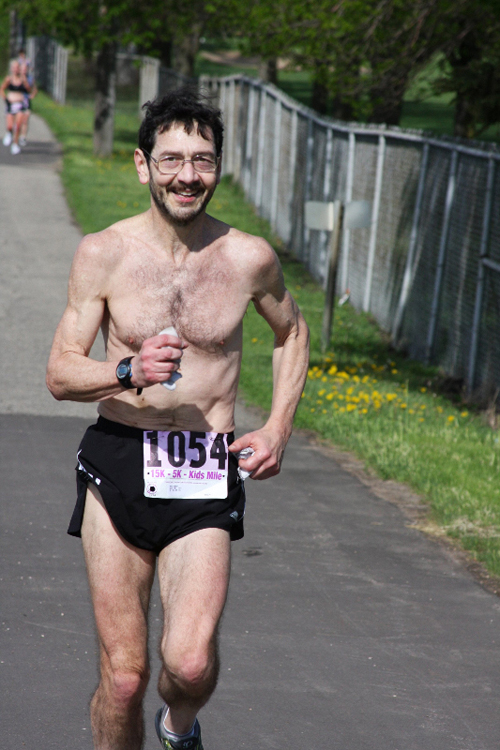Streak runners never take a day off

Minnesotans among the leaders
Stephen DeBoer of Rochester, Minn., ranks third on the Streakers International list of active runners at 46 years. Here hes taking part in the 2010 Spring Classic.
Running with Dave Foley
To clarify, streak running has nothing to do with that fad of the 1970s and 80s of running around with no clothes on. The streaking I’m discussing involves running every day. For these streak runners, the daily question on running isn’t “if” it’s “when.” That makes it simple. No making excuses or rationalizing. The run WILL happen sometime in that calendar day. Blizzard going on outside, knees hurting, burning up with fever, stuck in an airport – the run must happen. No day goes by without a run.
Ron Hill, three-time Olympian from Great Britain, started a streak on December 21, 1964 and for the next 52 years and 39 days, managed to at least log one mile of running every day. For the first 50 years of his streak he averaged more than 7-miles a day. In addition to winning the 1970 Boston Marathon, he later ran 2:09:28, the second person ever to break 2:10. At one time he held world records at 10-miles, 15-miles, and 25K on the roads. Of the 115 marathons he ran, only three weren’t under 2:50 Along the way he endured a broken sternum, bunion surgery and various flus and viruses, yet he managed to get out there every day. Heart problems finally broke his streak. In a statement released by Streak Runners International he wrote, “There was no other option but to stop. I owed it to my wife, my family, and friends, plus myself.”
While Hill’s streak ranks as the longest ever put together, according to Streak Runners International 744 are registered as having run at least one year without a break, 161 have been at it for over 10 years and 97 are past 20 years. With Ron Hill now retired, Jon Sutherland 66, of California with an unbroken string of nearly 48 years is now the leader. Two Minnesotans are near the top of the list.
To get some perspective I contacted Stephen DeBoer from Rochester, Minnesota whose 46 years of uninterrupted running puts him third on the Streakers International list of active runners. Stephen Gahje, from South Minneapolis, is fifth on the list with 45 ½ years.
Steve DeBoer at age 62, remains an avid racer, although he concedes he’s a long way from the days when ran PRs of a 4:47 mile, 33:16 for 10k, and a 2:42:18 best among the 62 marathons he’s completed. Since he started his streak in 1971 he’s logged over 156,000 miles (as of late March 2017). When asked about goals, he noted that he’d like to run the distance to the moon; that’s another 59,000 miles and to run a marathon when he’s 90.
From DeBoer I learned, that Minnesota with 120, has had more streak runners over the years than any other state – California is at 114 and Texas is 3rd with 84. The most from any city is Rochester, Minnesota with 15.
During the 1970s, Stephen Gahje focused on racing, racking up impressive PR’s in the mile, 4:24; 10K, 31:00: and 2:27:30 in the marathon. Since he started his streak in 1972, he’s logged over 112,300 miles. When asked about events that nearly ended his streak, he, like DeBoer, recalled coping with some leg injuries, but Gahje added, “When our youngest son was born and we were snowed in at the hospital, I ran in my street clothes wearing my wife’s hat and gloves.” With streak runners the adage “Where there’s a will there’s a way.”certainly applies.
I’ve always been curious about streak running. Ron Hill’s streak started 11 years before I began to run daily. And in every article about his elite performances on the world stage, there was invariably a note about his streak. I remember reading about him in Runner’s World. How he’d run on crutches after his auto accident, in airports while traveling, and when sick with a fever. I was a wimp compared to Ron.
Stephen Gathje, South Minneapolis, finds himself fifth on the active list at 45 ½ years. He’s running in the 2012 Charities Challenge Obesity.
The perseverance of streak runners while admirable, does draw some criticism. With never a day off, the situation looks ripe for developing overuse injuries. And most, who carry a streak, will tell stories of running through injuries and illness. Not a healthy practice, but when weighed against the benefits of guaranteed exercise every day, it may not be too great a price to pay.
What streak running does, is create the ultimate incentive for getting exercise every day. For those who seem to find excuses not to run, starting a streak could be the program for you. And then there’s Plan B. That’s where I am. I’ve tried carrying on a never-miss-a -day-of-running plan. Once I even had streak that extended to nine months. But when I’m injured or ill, I don’t run. Nor do I record miles when I’m out in the bush on a paddle and portage canoe trip or sea-kayaking the Great Lakes. What does keep me heading out on those days I’d rather stay in is my goal of logging 100,000 miles. Since 1975 I’ve run close to 93,000 miles. At 4 to 5 miles a day,1300-1400 a year, when I’m not in the wilderness or battling a health issue, you can bet I will be running.
Almost everyone remembers when they thought they would try running. Most start to accomplish a short term goal – run two-miles, race a 10k, then perhaps a marathon or they begin a program in order to shed some pounds. Invariably the exhilaration that comes with improving race times or weight loss that occurs in the first months or years of running tends to fade. The runs occur less frequently. Inevitably one quits running altogether.
What streaking or cumulative mileage totals do is provide the nudge toward making running a part of one one’s life.
And that’s a good place to be.



